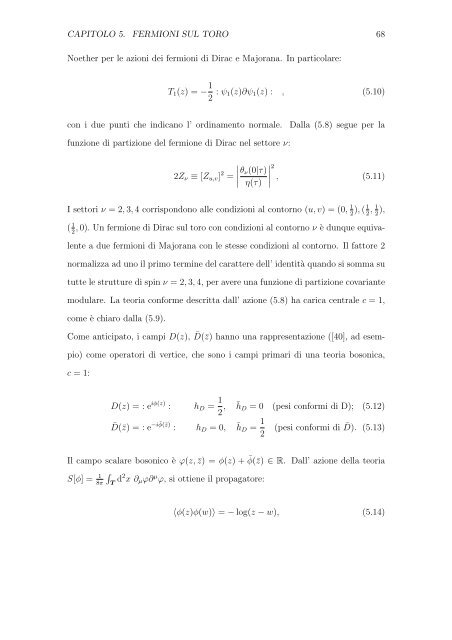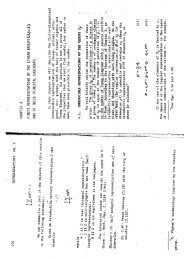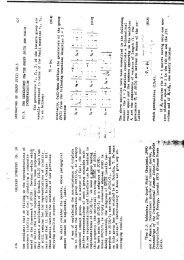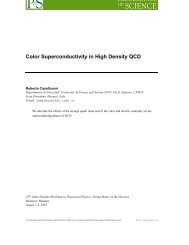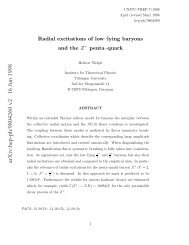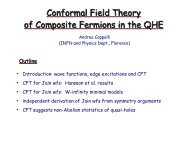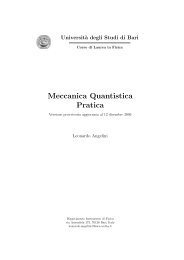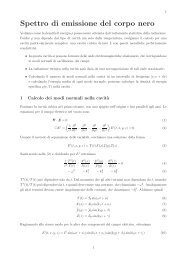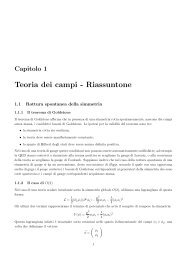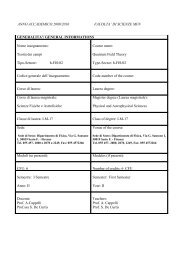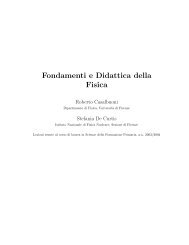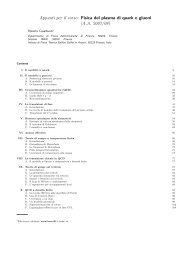entropia di entanglement in teorie invarianti conformi bidimensionali
entropia di entanglement in teorie invarianti conformi bidimensionali
entropia di entanglement in teorie invarianti conformi bidimensionali
Create successful ePaper yourself
Turn your PDF publications into a flip-book with our unique Google optimized e-Paper software.
CAPITOLO 5. FERMIONI SUL TORO 68<br />
Noether per le azioni dei fermioni <strong>di</strong> Dirac e Majorana. In particolare:<br />
T1(z) = − 1<br />
2 : ψ1(z)∂ψ1(z) : , (5.10)<br />
con i due punti che <strong>in</strong><strong>di</strong>cano l’ or<strong>di</strong>namento normale. Dalla (5.8) segue per la<br />
funzione <strong>di</strong> partizione del fermione <strong>di</strong> Dirac nel settore ν:<br />
2Zν ≡ [Zu,v] 2 =<br />
<br />
<br />
<br />
θν(0|τ) <br />
<br />
η(τ) <br />
2<br />
, (5.11)<br />
I settori ν = 2, 3, 4 corrispondono alle con<strong>di</strong>zioni al contorno (u, v) = (0, 1 1 1 ), ( , 2 2 2 ),<br />
( 1,<br />
0). Un fermione <strong>di</strong> Dirac sul toro con con<strong>di</strong>zioni al contorno ν è dunque equiva-<br />
2<br />
lente a due fermioni <strong>di</strong> Majorana con le stesse con<strong>di</strong>zioni al contorno. Il fattore 2<br />
normalizza ad uno il primo term<strong>in</strong>e del carattere dell’ identità quando si somma su<br />
tutte le strutture <strong>di</strong> sp<strong>in</strong> ν = 2, 3, 4, per avere una funzione <strong>di</strong> partizione covariante<br />
modulare. La teoria conforme descritta dall’ azione (5.8) ha carica centrale c = 1,<br />
come è chiaro dalla (5.9).<br />
Come anticipato, i campi D(z), ¯ D(¯z) hanno una rappresentazione ([40], ad esem-<br />
pio) come operatori <strong>di</strong> vertice, che sono i campi primari <strong>di</strong> una teoria bosonica,<br />
c = 1:<br />
D(z) = : e iφ(z) : hD = 1<br />
2 , ¯ hD = 0 (pesi <strong>conformi</strong> <strong>di</strong> D); (5.12)<br />
¯D(¯z) = : e −i ¯ φ(¯z) : hD = 0, ¯ hD = 1<br />
2<br />
(pesi <strong>conformi</strong> <strong>di</strong> ¯ D). (5.13)<br />
Il campo scalare bosonico è ϕ(z, ¯z) = φ(z) + ¯ φ(¯z) ∈ R. Dall’ azione della teoria<br />
<br />
S[φ] = 1<br />
8π<br />
T d2 x ∂µϕ∂ µ ϕ, si ottiene il propagatore:<br />
〈φ(z)φ(w)〉 = − log(z − w), (5.14)


